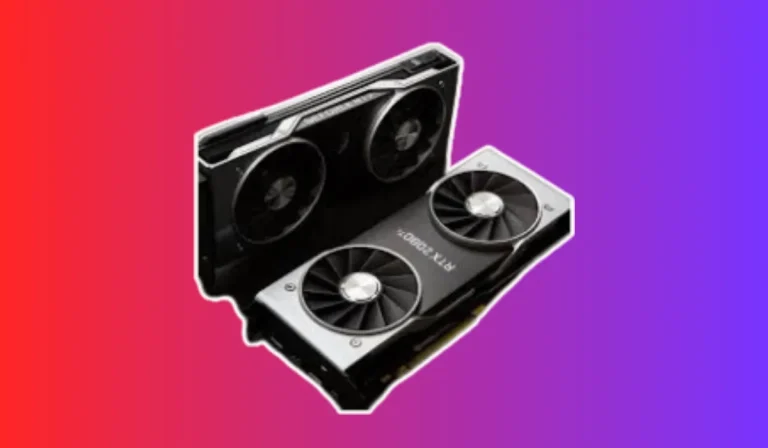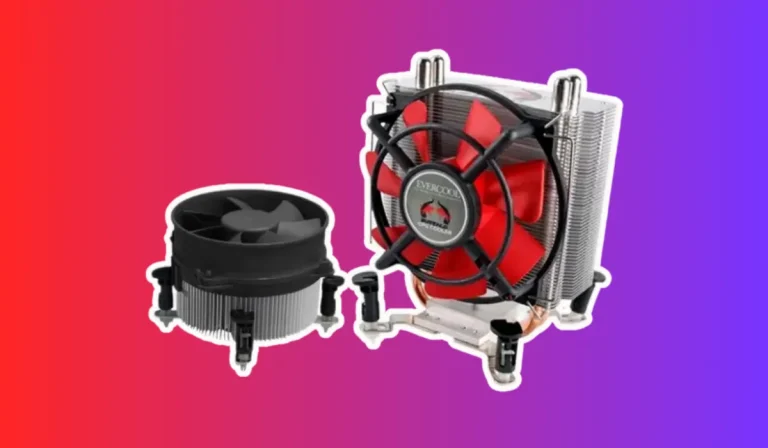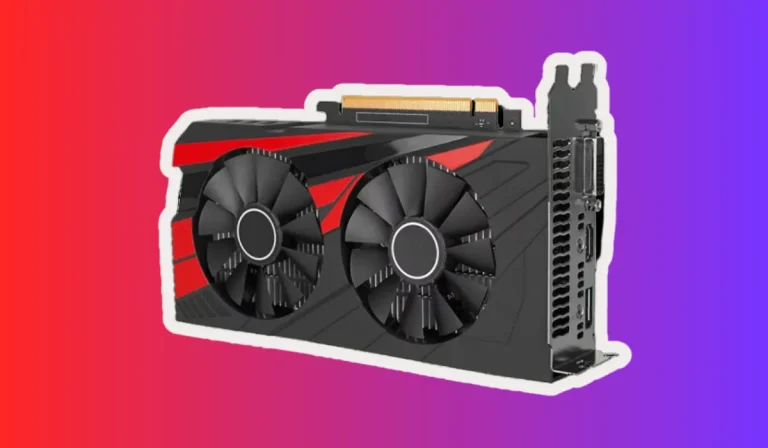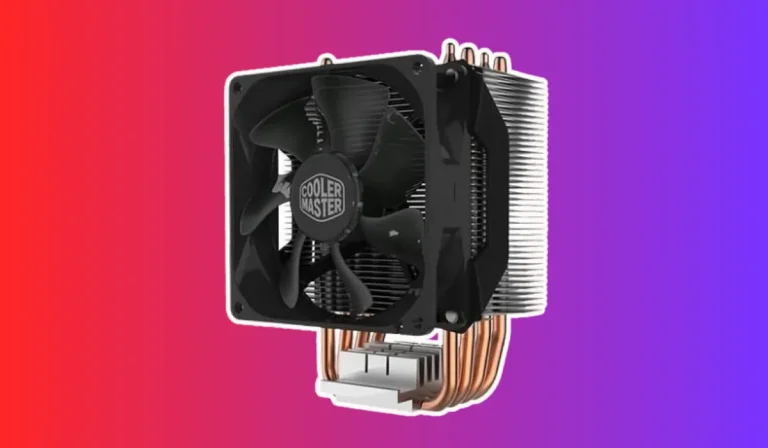Best GPU Laptop For Deep Learning
Looking for the best GPU laptop for deep learning? Look no further! We’ve got you covered with this ultimate guide. Whether you’re a data scientist, AI enthusiast, or just starting in the world of machine learning, having a powerhouse laptop with a top-notch graphics processing unit (GPU) is essential. Join us as we dive into the world of deep-learning laptops and find the perfect one for you!
Best GPU Laptop for Deep Learning
| No. | Product Name | Check Price |
| 1. | ASUS ROG Zephyrus G14 | Check Price |
| 2. | MSI GS66 Stealth | Check Price |
| 3. | Dell XPS 15 | Check Price |
| 4. | Razer Blade 15 | Check Price |
| 5. | Lenovo Legion 5 | Check Price |
| 6. | HP Omen 15 | Check Price |
1. ASUS ROG Zephyrus G14
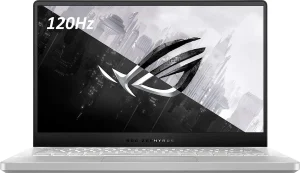
| Specification | Value |
| Display | 14″ Full HD, 1920 x 1080, 120Hz refresh rate |
| Processor | AMD Ryzen 9 4900HS (up to 4.30GHz, 8 cores) |
| Storage | 1TB SSD |
| Memory | 16GB DDR4 RAM |
| Graphics | NVIDIA GeForce RTX 2060 Max-Q, 6GB GDDR6 |
| Connectivity | WiFi 6 (802.11 ax) |
| Operating System | Windows 10 Home |
| Weight & Thickness | 3.64 lbs, 0.7″ thin |
ASUS ROG Zephyrus G14 is undoubtedly one of the best GPU laptops for deep learning. As someone deeply passionate about deep learning, finding the perfect laptop with the best GPU is crucial.
After extensive research, I stumbled upon the ASUS ROG Zephyrus G14, and let me tell you, it has exceeded all my expectations.
The 14″ Full HD display with a resolution of 1920 x 1080 and a 120Hz refresh rate delivers stunning visuals, making it a treat for both work and play. The display is sharp and vibrant, allowing me to analyze complex datasets and train deep learning models with ease.
Powered by the latest AMD Ryzen 9 4900HS processor, this laptop truly stands out from the crowd. With 8 cores and a maximum clock speed of 4.30GHz, it outperforms even some of the 10th Gen Intel Core i7 processors.
This means faster data processing, seamless multitasking, and lightning-fast performance for all my deep learning needs.
The generous 1TB SSD provides ample storage space for my datasets, while the 16GB DDR4 RAM ensures smooth and lag-free operations. Whether I’m running resource-intensive algorithms or training neural networks, this laptop handles it all without breaking a sweat.
The NVIDIA GeForce RTX 2060 Max-Q graphics card with 6GB GDDR6 dedicated video memory is a true game-changer. It not only delivers exceptional graphics for gaming but also enhances the performance of deep learning tasks. This laptop is truly virtual reality-ready, allowing me to explore immersive AI experiences effortlessly.
One of the standout features of this laptop is the speakers with Smart AMP Technology and Dolby Atmos. The two 2.5W speakers produce incredible Dolby Atmos sound, making my deep learning sessions even more enjoyable. The wireless connectivity options, including WiFi 6 (802.11 ax), ensure seamless internet access and fast data transfer.
The chiclet keyboard with white backlighting is a delight to type on, even in dimly lit environments. The keys are well-spaced and provide accurate typing, enabling me to code and document my deep-learning projects with ease.
Weighing just 3.64 lbs and measuring 0.7″ thin, this laptop is incredibly portable. I can take it with me wherever I go, whether it’s to the office, a coffee shop, or a conference. It’s the perfect companion for deep learning enthusiasts who value mobility without compromising on performance.
In conclusion, the ASUS ROG Zephyrus G14 is the ultimate choice for anyone in search of the best GPU laptop for deep learning. With its powerful specifications, exceptional graphics, and immersive sound, it delivers an unparalleled experience. However, it’s worth noting that the battery life could be improved, and some users might find the absence of an integrated webcam inconvenient.
Pros:
- Powerful AMD Ryzen 9 processor
- Stunning 14″ Full HD display with a high refresh rate
- Ample storage space with a 1TB SSD
- Exceptional graphics performance with NVIDIA GeForce RTX 2060 Max-Q
- Portable and lightweight design
Cons:
- Limited battery life
- No integrated webcam
2. MSI GS66 Stealth
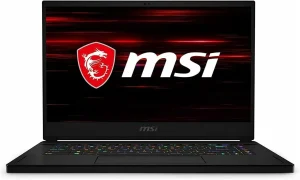
| Specification | Value |
| Aspect Ratio | 16:9 |
| Display | 15.6″ FHD, Anti-Glare Wide View Angle, 240Hz, 3ms |
| Processor | Intel Core i7-10750H |
| Graphics | NVIDIA GeForce RTX 2070 Max-Q |
| Memory | 16GB (8G*2) DDR4 2666MHz |
| Storage | 1TB NVMe SSD |
| Connectivity | Intel Wi-Fi 6 AX201 (2*2 ax) |
MSI GS66 Stealth is undoubtedly one of the best GPU laptops for deep learning. As an avid deep-learning enthusiast, I’ve always been on the lookout for the best GPU laptop that can handle the intense demands of my projects.
After extensive research and personal experience, I can confidently say that the MSI GS66 Stealth is a true powerhouse that exceeds expectations.
The 15.6″ FHD display with an anti-glare wide view angle, featuring an impressive 240Hz refresh rate and a swift 3ms response time, delivers an immersive visual experience.
Whether I’m training complex neural networks or analyzing vast datasets, the display’s clarity and smoothness provide a significant advantage in my deep learning endeavors.
Under the hood, the Intel Core i7-10750H processor ensures high-performance computing. With its six cores and twelve threads, it effortlessly handles heavy workloads, allowing me to run multiple processes simultaneously without any noticeable lag. This laptop truly shines when it comes to deep learning tasks.
The NVIDIA GeForce RTX 2070 Max-Q graphics card is a game-changer for deep learning enthusiasts. With its dedicated GPU memory and impressive performance, it accelerates training times and enhances the overall efficiency of my models. The GPU’s capabilities make it a top choice for those seeking the best GPU laptop for deep learning.
When it comes to memory and storage, the MSI GS66 Stealth doesn’t disappoint. With 16GB of DDR4 memory running at 2666MHz, I never have to worry about running out of memory during intense deep-learning sessions.
The 1TB NVMe SSD provides ample storage space for my datasets, ensuring fast data access and seamless workflow.
Connectivity-wise, the Intel Wi-Fi 6 AX201 offers lightning-fast wireless connectivity, allowing me to transfer large datasets quickly. The 2*2 ax configuration ensures stable and reliable connections, which is crucial for downloading large models or sharing results with colleagues.
Now, let’s talk about the pros and cons of the MSI GS66 Stealth:
Pros:
- Impressive 240Hz display with a wide view angle for immersive visual experience
- Powerful Intel Core i7 processor for high-performance computing
- NVIDIA GeForce RTX 2070 Max-Q graphics card for accelerated deep learning tasks
- Ample memory and storage space for seamless workflow
- Fast and reliable wireless connectivity with Intel Wi-Fi 6 AX201
Cons:
- The laptop can get warm under heavy workloads, requiring additional cooling measures
- The keyboard layout may take some time to get used to for some users
3. Dell XPS 15
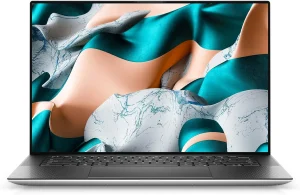
| Specification | Value |
| Touchpad Size | 62% larger |
| Screen Size | 5% larger |
| Footprint | 5.6% smaller |
| Display | 16:10 FHD+ edge-to-edge, DisplayHDR 400, Dolby Vision |
| Eyesafe Display Technology | Integrated |
| Audio | Quad speaker design with Waves Nx audio |
| Design | High-polished diamond-cut sidewalls |
Dell XPS 15 is a remarkable choice for deep learning enthusiasts who value both performance and style. As a deep learning enthusiast, I’ve always sought a powerful and stylish laptop that could handle the demanding computational tasks involved in training complex neural networks.
After extensive research and personal experience, I can confidently say that the Dell XPS 15 is a game-changer in the realm of deep learning.
The Dell XPS 15 boasts several noteworthy features that make it stand out from the competition. Firstly, the 16:10 FHD+ edge-to-edge display, equipped with DisplayHDR 400 and Dolby Vision, delivers stunning visuals with vivid colors and impressive contrast. This display provides an immersive experience, allowing me to delve deep into my deep learning projects.
One of the standout features of the Dell XPS 15 is its integration of Eyesafe display technology. This technology reduces harmful blue light emissions, ensuring that my eyes remain comfortable even during long hours of deep learning work. It’s a thoughtful addition that prioritizes user well-being.
When it comes to audio, the Dell XPS 15’s quad-speaker design with Waves Nx audio truly enhances the overall experience. The audio quality is crisp and immersive, allowing me to fully engage with multimedia content and analyze audio-based deep learning models effectively.
The high-polished diamond-cut sidewalls of the Dell XPS 15 give it a premium and sleek appearance. It’s a laptop that not only performs exceptionally well but also turns heads with its elegant design. The attention to detail in its aesthetics is a testament to Dell’s commitment to excellence.
Now, let’s discuss the pros and cons of the Dell XPS 15:
Pros:
- A larger touchpad enhances navigation and ease of use
- Bigger screen size provides a more immersive viewing experience
- A smaller footprint makes it portable without compromising display size
- DisplayHDR 400 and Dolby Vision deliver stunning visuals
- Eyesafe display technology for reduced blue light emissions
- Quad speaker design with Waves Nx audio for an immersive audio experience
- Stylish and premium design with high-polished diamond-cut sidewalls
Cons:
- Limited GPU options compared to some other deep-learning laptops
- Can get warm under heavy workloads, requiring additional cooling measures
4. Razer Blade 15
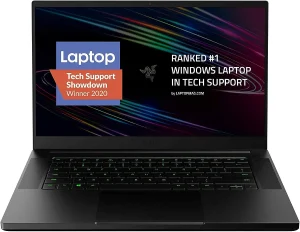
| Specification | Value |
| Processor | 10th Gen Intel Core i7-10750H |
| Processor Speed | Up to 5.0 GHz max turbo |
| Cores | 6 |
| Graphics | NVIDIA GeForce GTX 1660 Ti |
| Display | 15.6″ Full HD, 144Hz, thin bezel |
| Frame Material | CNC aluminum unibody |
| Thickness | 0.78″ |
| Connectivity | Wi-Fi 6, Gigabit Ethernet, Thunderbolt 3, USB type-A/C, HDMI |
Razer Blade 15 is an exceptional choice for deep learning enthusiasts seeking a powerful and stylish laptop. As someone deeply invested in the world of deep learning, finding the perfect laptop that combines powerful performance, stunning visuals, and a sleek design has always been a top priority.
After extensive research and personal experience, I can confidently say that the Razer Blade 15 is a game-changer in the realm of deep learning.
The Razer Blade 15 comes equipped with the 10th Gen Intel Core i7-10750H processor, providing an impressive level of performance with up to 5.0 GHz max turbo and 6 cores.
This processing power ensures the smooth and efficient execution of complex deep learning tasks, allowing me to tackle demanding neural network training with ease.
When it comes to graphics, the NVIDIA GeForce GTX 1660 Ti is a supercharger that delivers blazing-fast performance for both deep learning and popular games.
The combination of powerful processing and graphics capabilities enables seamless multitasking and ensures that my deep-learning models run efficiently and effectively.
The Razer Blade 15’s 15.6″ Full HD display with a fast 144Hz refresh rate and thin bezel takes the visual experience to a whole new level. The vibrant colors and sharp details provide an immersive viewing experience, allowing me to analyze and visualize deep learning results with precision.
One of the standout features of the Razer Blade 15 is its thin and compact design. The CNC aluminum unibody frame not only houses incredible performance but also ensures durability.
With a thickness of just 0.78″, this laptop is incredibly portable without compromising on power. It’s a perfect companion for deep learning on the go.
Connectivity options on the Razer Blade 15 are plentiful, offering a desktop-class experience. With Wi-Fi 6, Gigabit Ethernet, Thunderbolt 3, USB type-A and type-C ports, and HDMI, I have all the necessary connections to seamlessly transfer data, connect to external displays, and collaborate with ease.
Now, let’s discuss the pros and cons of the Razer Blade 15:
Pros:
- Powerful 10th Gen Intel Core i7 processor with up to 5.0 GHz max turbo
- NVIDIA GeForce GTX 1660 Ti graphics for exceptional deep learning performance
- Fast 144Hz refresh rate and thin bezel for an immersive visual experience
- Thin and compact CNC aluminum unibody design for portability without sacrificing power
- Versatile connectivity options for a desktop-class experience
Cons:
- Limited GPU options compared to some other deep-learning laptops
- May get warm under heavy workloads, requiring additional cooling measures
5. Lenovo Legion 5
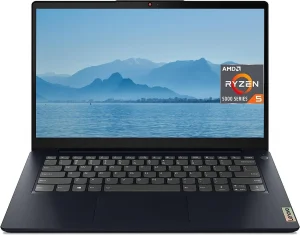
| Specification | Value |
| Processor | AMD Ryzen 7 4800H |
| Memory | 16GB 3200MHz DDR4 |
| Storage | 512GB M.2 NVMe PCIe SSD |
| Display | 15.6″ FHD (1920 x 1080) IPS, 144Hz refresh rate |
| Graphics | NVIDIA GeForce GTX 1660Ti |
| Dual Burn Support | Yes |
| Legion Coldfront 2.0 | Yes |
| Keyboard | Legion TrueStrike with soft-landing switches |
Lenovo Legion 5 is a top contender for the title of the best GPU laptop for deep learning. When it comes to finding the best GPU laptop for deep learning, the Lenovo Legion 5 stands out as a powerhouse that combines exceptional performance, immersive visuals, and intelligent design.
As a deep learning enthusiast myself, I’ve had the pleasure of experiencing the remarkable capabilities of this laptop firsthand.
The Lenovo Legion 5 is armed with the AMD Ryzen 7 4800H mobile processor, 16GB of high-speed DDR4 memory, and a 512GB M.2 NVMe PCIe SSD. This powerful combination ensures lightning-fast processing and efficient storage, enabling smooth and seamless deep-learning operations. With this laptop, I’ve been able to handle complex neural network training and data analysis with ease.
The 15.6″ FHD IPS display with a 144Hz refresh rate brings deep learning models to life, delivering outstanding clarity and vibrant colors. Whether I’m visualizing complex data or diving into the latest research papers, the Legion 5’s display provides an immersive experience that enhances my productivity and understanding.
The NVIDIA GeForce GTX 1660Ti GPU is a true supercharger, allowing the Legion 5 to handle both intensive deep-learning tasks and the latest gaming titles.
It provides exceptional performance and ensures smooth multitasking, making it an ideal companion for those who enjoy both work and play.
One standout feature of the Legion 5 is its Dual Burn Support, which intelligently pushes the CPU and GPU together to deliver improved framerates and overall performance.
This feature enhances the deep learning experience by maximizing the laptop’s capabilities, allowing for faster training and inference times.
To ensure optimal thermal performance, the Legion 5 is equipped with Legion Coldfront 2.0. This innovative thermal tuning technology keeps the laptop cool, even during extended deep learning sessions, preventing thermal throttling and maintaining peak performance.
The Legion TrueStrike keyboard with soft-landing switches is a joy to use. The hair-trigger inputs enable precise and responsive typing, which is essential for coding and other deep-learning tasks. The keyboard’s ergonomic design ensures comfort during long sessions, making it a pleasure to work with.
Now, let’s take a look at the pros and cons of the Lenovo Legion 5:
Pros:
- Powerful AMD Ryzen 7 processor for exceptional deep learning performance
- High-speed DDR4 memory and NVMe SSD for lightning-fast processing and storage
- Stunning 15.6″ FHD IPS display with a 144Hz refresh rate for immersive visuals
- NVIDIA GeForce GTX 1660Ti GPU for exceptional graphics performance
- Dual Burn Support for improved framerates and overall performance
- Legion Coldfront 2.0 for efficient thermal management
- Comfortable and responsive Legion TrueStrike keyboard
Cons:
- Limited storage capacity for those with extensive deep-learning datasets
- Slightly heavier than some other deep-learning laptops
6. HP Omen 15
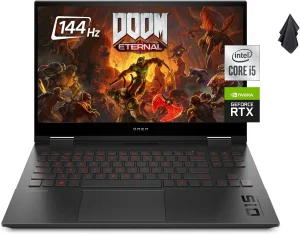
| Specification | Value |
| Processor | Intel Core i5-10300H |
| Graphics | NVIDIA GeForce RTX 3060 Laptop GPU (6 GB GDDR6) |
| Display | 15.6″ FHD, 144 Hz, IPS, anti-glare, micro-edge |
| RAM | 16GB high-bandwidth RAM |
| Storage | 1 TB PCIe Solid State Drive |
| Operating System | Windows 10 Home 64-bit |
| Ports | 1x USB Type-C, 3x USB Type-A, 1x HDMI, 1x DP, 1x headphone / microphone combo jack (3.5mm), 1x RJ-45 Ethernet, 1x Card Reader |
| Audio | Audio by Bang & Olufsen with dual speakers |
| Keyboard | Backlit Keyboard |
| Included Accessories | Bundled with Microfiber Cloth |
HP Omen 15 is a solid contender for the title of the best GPU laptop for deep learning. As a deep learning enthusiast, I understand the importance of having a powerful and reliable laptop for intensive computational tasks. The HP Omen 15 is a laptop that has caught my attention and has proven to be a great companion in my deep learning journey.
Under the hood, the HP Omen 15 is equipped with an Intel Core i5-10300H processor, providing a solid foundation for deep learning tasks. Combined with the NVIDIA GeForce RTX 3060 Laptop GPU with 6 GB of dedicated GDDR6 memory, this laptop delivers exceptional graphical performance, making it one of the best GPU laptops for deep learning.
The 15.6″ FHD IPS display with a 144 Hz refresh rate provides a visually stunning experience. Whether I’m training complex models or visualizing data, the Omen 15’s crisp and vibrant display ensures that every detail is clear and immersive. The anti-glare and micro-edge design further enhance the viewing experience, reducing distractions and allowing me to focus on my work.
With 16GB of high-bandwidth RAM and a spacious 1 TB PCIe Solid State Drive, the Omen 15 offers ample memory and storage capacity. This allows me to run multiple applications and store large datasets without any performance bottlenecks.
The fast bootup and data transfer speeds provided by the SSD greatly contribute to my productivity, ensuring that I can quickly access and analyze my deep learning projects.
Running on Windows 10 Home 64-bit, the Omen 15 provides a familiar and user-friendly operating system. It supports a wide range of software and tools commonly used in the deep learning community, making it easy to set up and work with.
The Omen 15 also offers a versatile selection of ports, including USB Type-C, USB Type-A, HDMI, DP, and more. These ports allow for seamless connectivity with external devices, such as monitors and peripherals, expanding the laptop’s capabilities and flexibility.
Audio is another aspect where the Omen 15 shines. With audio tuned by Bang & Olufsen and dual speakers, the laptop delivers rich and immersive sound quality. Whether I’m watching videos or participating in virtual meetings, the audio experience is a delight.
The backlit keyboard is a convenient feature, especially for those late-night deep learning sessions. It allows me to work comfortably in low-light environments, ensuring that I can stay productive without straining my eyes.
Now, let’s take a look at the pros and cons of the HP Omen 15:
Pros:
- Powerful Intel Core i5 processor and NVIDIA GeForce RTX 3060 GPU for exceptional deep learning performance
- Vivid 15.6″ FHD IPS display with a 144 Hz refresh rate for immersive visuals
- Ample 16GB RAM and 1 TB PCIe SSD for smooth multitasking and storage
- Wide selection of ports for versatile connectivity
- Audio by Bang & Olufsen with dual speakers for an immersive sound experience
- Backlit keyboard for comfortable typing in low-light environments
Cons:
- The Intel Core i5 processor may not be as powerful as higher-end options for extremely demanding deep-learning tasks
- Some users may prefer a larger display for enhanced productivity
Buying Guide: Best GPU Laptop for Deep Learning
Are you on the hunt for the perfect laptop to fuel your deep-learning endeavors? With the increasing demand for computational power, it’s crucial to choose a laptop that can handle the intensive tasks required for deep learning. To help you make an informed decision, here are six essential factors to consider when choosing the best GPU laptop for deep learning:
1. Processing Power: Deep learning models require significant computational power, so it’s essential to select a laptop with a powerful processor.
Look for laptops equipped with high-performance CPUs, such as Intel Core i7 or i9, as they can handle complex calculations and data processing efficiently. Consider your specific deep learning requirements and choose a processor that aligns with your needs.
2. Graphics Processing Unit (GPU): The GPU plays a crucial role in deep learning tasks, as it accelerates the training and inference processes.
Look for laptops with dedicated GPUs, such as the NVIDIA GeForce RTX series, as they offer excellent performance for deep learning workloads. The amount of dedicated VRAM is also important, with higher VRAM allowing for the handling of larger datasets.
3. RAM and Storage: Deep learning often involves working with large datasets and running memory-intensive algorithms. Opt for laptops with ample RAM, preferably 16GB or more, to ensure smooth multitasking and efficient model training.
Additionally, consider laptops with fast and spacious storage options, such as PCIe solid-state drives (SSDs), to facilitate quick data access and transfer.
4. Display Quality: A high-quality display is essential for deep learning tasks, as it allows for accurate visualization of data and model outputs. Look for laptops with IPS panels, as they provide wide viewing angles and accurate color reproduction.
A higher resolution display, such as Full HD (1920 x 1080) or even 4K, can enhance the clarity of visuals. Additionally, consider a show with a high refresh rate (e.g., 144 Hz) to reduce motion blur during fast-paced visualizations.
5. Connectivity and Ports: Deep learning often requires connecting multiple peripherals and external devices. Ensure that the laptop you choose has a variety of ports, such as USB Type-C, USB Type-A, HDMI, and DisplayPort, to accommodate your connectivity needs. This will allow you to connect external monitors, GPUs, and other devices seamlessly.
6. Portability and Battery Life: If you plan to work on the go or attend conferences and workshops, portability becomes a crucial factor. Consider laptops that strike a balance between power and portability, with lightweight designs and long battery life. This will ensure that you can work efficiently without being tethered to a power outlet.
Based on these factors, I would highly recommend considering the HP Omen 15 from the above list. It offers a powerful Intel Core i5 processor and an NVIDIA GeForce RTX 3060 GPU, making it an excellent choice for deep learning tasks.
The laptop’s 16GB RAM and 1TB PCIe SSD provide ample memory and storage capacity, while the 15.6″ FHD IPS display with a 144 Hz refresh rate ensures a visually stunning experience. With its versatile connectivity options and backlit keyboard, the HP Omen 15 offers a well-rounded package for deep learning enthusiasts.
FAQ’s
1. Do I need a laptop with the latest GPU model for deep learning?
While having the latest GPU model can provide better performance, it is not always necessary for deep learning. Older GPU models can still handle deep learning tasks effectively, depending on the specific requirements of your projects. Consider factors like VRAM, CUDA cores, and memory bandwidth in addition to the GPU model.
2. Can I use a gaming laptop for deep learning purposes?
Gaming laptops can be suitable for deep learning due to their powerful GPUs. However, it’s important to note that not all gaming laptops are optimized for deep learning tasks. Look for gaming laptops with GPUs specifically designed for deep learning, such as the NVIDIA RTX or Quadro series, to ensure optimal performance.
3. Are laptops with liquid cooling necessary for deep learning workloads?
While liquid cooling can help dissipate heat more efficiently, it is not a strict requirement for deep learning tasks. Many laptops come equipped with effective air cooling systems that can handle the heat generated by GPUs during intense computations. However, if you plan to engage in heavy and prolonged deep learning workloads, laptops with advanced cooling systems might be worth considering.
4. Can I use an external GPU enclosure with any laptop for deep learning?
Not all laptops are compatible with external GPU enclosures. The compatibility depends on the laptop’s design, available ports, and support for external GPU connectivity, such as Thunderbolt 3. Before investing in an external GPU enclosure, ensure that your laptop is compatible and can provide sufficient power to the external GPU.
5. Is overclocking the GPU necessary for better deep learning performance?
Overclocking the GPU can potentially provide a performance boost, but it is not necessary for deep learning tasks. Deep learning workloads are already computationally demanding, and overclocking may lead to increased power consumption and heat generation.
Conclusion
Choosing the best GPU laptop for deep learning is an important decision that requires careful consideration of various factors. From processing power to GPU capabilities, RAM and storage options, display quality, connectivity, and portability, each aspect plays a crucial role in enhancing your deep learning experience.
By thoroughly evaluating your specific needs and aligning them with the available options in the market, you can find a laptop that empowers you to tackle complex deep-learning tasks with ease.
So, take your time, explore the options, and make an informed decision that sets you up for success in your deep learning journey. Happy computing!

